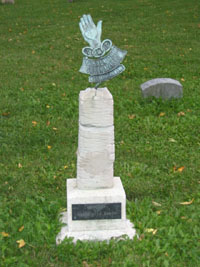 |
Minneapolis Pioneers and Soldiers Memorial Cemetery History Page Alley Article |
| Home | Burial Search | Friends | History | Photo Gallery | Visitor Information |
| Alley Articles |
|
This article originally appeared in the Phillips community's Alley Newspaper, October 2005.
Gravestones Link Us to the Past Grave markers and monuments are intended to provide us with permanent reminders of friends and relatives who are no longer with us. But many of the markers in Minneapolis Pioneers and Soldiers Memorial Cemetery turned out not to be the permanent reminders that they were intended to be. In 1938, the Works Progress Administration conducted a marker survey and identified around 2,500 markers. This past summer, Jeff Adams, an intern with the Heritage Preservation Division of Minneapolis’ Department of Community Planning and Economic Development, counted only 1,820 markers, so the cemetery has lost almost 700 markers in about sixty years. Some of the loss was due to natural weathering and erosion, but much of it was due to vandalism. The markers and monuments that remain are quite modest compared to those in many other local cemeteries. The majority are simple upright tablets made of marble or sandstone and inscribed with names and dates. Many of the markers are written in German, Swedish or Norwegian, the languages of many of Minneapolis’ earliest immigrants. Obelisks ranging from four to six feet tall are also common, as are the small marble markers topped with carved lambs that were often used to mark children’s graves. The materials vary greatly, from various types of stone, such as marble and sandstone, to metals, such as iron and zinc. Cemetery records indicate that a number of graves once were marked with wooden crosses which have long since disappeared. Others were marked with trees or shrubs, many of which still exist. Close study of the markers’ styles, materials, and inscriptions can provide valuable clues to society’s attitudes toward death at particular times in history. Markers can also provide clues to an individual’s character. After examining the marker for Soren Madsen, it is not hard to imagine what type of person he was or how his friends felt about him. His marker is a small pillar, topped with a hand sculpted of bronze. In the palm of the hand is a heart. Beneath the hand are three links of a chain which enclose the letters, F, L and T. The letters stand for friendship, love and truth, the values espoused by Madsen’s fraternal organization. At the base of the marker there is a plaque noting that the monument was erected by members of the Flour City Lodge, a Minneapolis chapter of the Odd Fellows. Madsen lost his life in the course of performing a good deed. On February 19, 1916, he was on his way home from visiting a friend who was in the hospital when he lost his way in a blizzard. He was unable to find his way back to the farm where he worked and froze to death during the storm. His body was recovered by his friends, and they are the ones responsible for providing us with a permanent reminder of the principles that Soren Madsen stood for. And they are also the ones who chose to top his marker with a hand that seems to be waving a friendly greeting. Next Article -> Cyrus Redlon -- November 2005 |
|
©Friends of the Cemetery, 2005-2008 Contact us at history@friendsofthecemetery.org |
File last updated: Monday January 14, 2008 |
 Soren Madsen
Soren Madsen